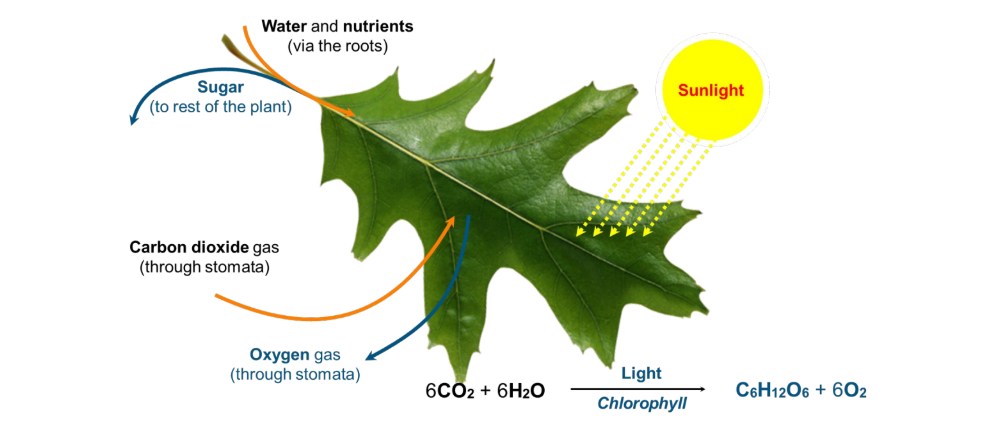Photosynthesis

The Electromagnetic Spectrum
Light is a form of energy known as electromagnetic radiation
The segment of the electromagnetic spectrum most important to life is the
narrow band between about 380 and 750 nanometres (nm)
This radiation is known as visible light because it is detected as colours by the
human eye and drives photosynthesis
Photosynthetic Pigments
Substances that absorb visible light are called biological pigments
The photosynthetic pigments of plants fall into two categories:
Chlorophylls (A and B), which absorb red and blue-violet light
They are the main photosynthetic pigment in plants and give leaves their green colour (as
the green wavelengths are not absorbed)
Carotenoids, which absorb strongly in the blue-violet, appear orange, yellow, or
red
They are considered to be accessory pigments
Note: some of the other pigments become visible during autumn when green
chlorophyl is broken down. Some of these pigments aid photosynthesis, such
as carotenoids, some are related to other functions.
Absorption Spectrum
The absorption
spectrum of different
photosynthetic
pigments provides
clues to their role in
photosynthesis, since
light can only
perform work if it is
absorbed
Action Spectrum
An action spectrum
profiles the effectiveness
of different wavelength
light in fueling
photosynthesis
It is obtained by plotting
wavelength against a
measure of
photosynthetic rate (e.g.
CO2 consumption)
Factors Affecting Photosynthetic Rate
The rate at which plants can produce carbohydrate
(the photosynthetic rate) is dependent on several
environmental factors
This is due to many steps requiring catalysis by
enzymes
Some factors have a greater effect than others, these
include:
The amount of light available
The level of carbon dioxide (CO2)
The temperature
Carbon Fixation
The Calvin cycle begins with the carboxylation of ribulose bisphosphate
(RuBP)
The enzyme Rubisco catalyses the attachment of carbon dioxide (1C) to RuBP (5C)
The 6C compound that is formed is unstable and breaks down into two 3C
molecules
These two 3C molecules are called glycerate-3-phosphate (GP)
Reduction of GP
The next stage of the Calvin cycle involves the reduction of glycerate-3-
phosphate (GP)
GP is converted into an alternative 3C compound called triose phosphate (TP)
This restructuring of the molecule is mediated by ATP and NADPH (reduction)
ATP and NADPH are produced by the light dependent reactions (non-cyclic)
Regeneration of RuBP
The final stage of the Calvin cycle involves the formation of carbon
compounds
One of the TP molecules is used to produce carbon compounds (carbohydrates)
The remaining TP molecules are used to regenerate RuBP stocks (requires ATP)
Two cycles of the Calvin cycle would be required to produce a typical hexose
sugar (e.g. glucose)
Light Independent Reactions

Conversion of Triose Phosphate
Triose phosphate, produced during photosynthesis, is
the base product leading to the formation of many
other molecules. It is converted to:
Glucose, the fuel for cellular respiration
Cellulose, a component of plant cell walls is formed using
glucose
Starch granules act as a reserve supply of energy, to be
converted back into glucose when required
Glucose is converted to other sugars such as fructose,
found in ripe fruit, and sucrose, found in sugar cane
Lipids and amino acids